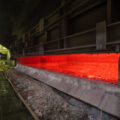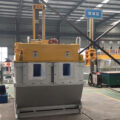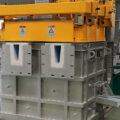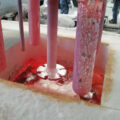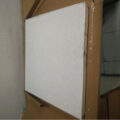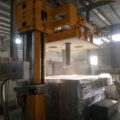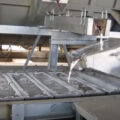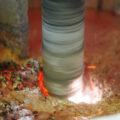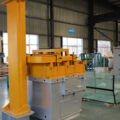Metal degassing system is mainly used for the hydrogen (H) and slags removal from molten aluminum. It takes the gas flotation principle. The rotor takes inert gas or mixture of chlorine and inert gas into molten aluminum and smashes the gas into dispersed tiny bubbles, the bubbles can absorb the hydrogen and inclusions, then the bubbles rise to the molten aluminum surface, and remove them.
When the hydrogen content in the melt is large and the degassing is not complete, the hydrogen gas exists in the form of bubbles and is retained after the metal solidifies, forming spherical cavities in the metal, that is, pores. The structure of the stomata is characterized by round holes, and the inner surface is smooth and bright.

The main factors affecting the formation of stomata
(1) The original gas content of the melt. The greater the original gas content of the melt, the more gas will be precipitated when the temperature is lowered; the greater the supersaturation concentration of the liquid phase on the crystallization interface, the wider the supersaturation zone for the formation of bubbles; the longer the time, the more the formation of pores will be promoted.
(2) Cooling rate. The faster the cooling rate of the ingot, the less the gas diffusion and the too late to precipitate, so the supersaturation of the gas that does not produce pores is allowed to increase, resulting in the narrower the supersaturation area where bubbles are formed. At the same time, the greater the cooling rate, the narrower the transition zone, and the dendrites are less likely to close the liquid phase, thus reducing the tendency to form pores.
(3) Alloy composition. The formation of pores is mainly affected by the alloy composition, which affects the original hydrogen content, the diffusion coefficient of hydrogen in the alloy, the distribution coefficient, and the size of the crystallization zone.
(4) Ingot casting process conditions. Mainly affect the formation and distribution of pores by changing the crystallization method and the size of the transition zone
(5) The content of non-metallic inclusions. The lower the content of non-metallic inclusions, the higher the critical hydrogen content that allows pores to be generated.
The measures to prevent porosity in the ingot are:
- Take measures from five aspects: raw and auxiliary materials, fuels, tools, metal degassing system, and refining processes to reduce the gas content in the melt.
- Properly increase the casting temperature, reduce the casting speed, establish good gassing conditions, and facilitate the floating of bubbles.
- Improve the cooling rate of high ingots to prevent the precipitation of gas in the form of bubbles.


